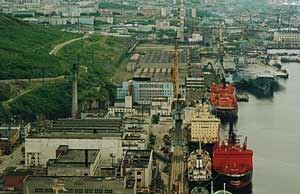
New Managing Director for Bellona Norway
The Board of the Bellona Foundation has appointed former Minister of Climate and the Environment Sveinung Rotevatn as Managing Director of Bellona No...
News

Publish date: March 4, 2011
Written by: Alexey Pavlov
Translated by: Charles Digges
News
The vessel was built under the framework of a 2003 agreement on bilateral cooperation on dismantling Russia’s submarine fleet. The construction itself was agreed in July 2002 after the G8 summit in Kananaskis, Canada, where world leaders agreed to the Global Partnership against the Spread of Weapons and Materials of Mass Destruction.
Under the Global Partnership, G-8 nations were to provide $20 million between 2002 and 2012 – $10 billion coming from the United States and another $10 from the group’s other members.
In 2005, apparent shortfalls in money pledged and spent by member nations were discussed by the G-8 in Tokyo. Italy was among those that renewed its commitment to the Global Partnership, plugging €360 million ($560 million) into the agreement on top of other funding it had agreed to in 2003.
The contract for the Rossita – which will go into service this year – was signed between deputy director of Russia’s state nuclear corporation Rosatom Yevgeny Yevstatov, and Giovanni Battista Narbone, head of the industrial policy management department of Italy’s Ministry of Economic Development in April of 2008.
The Rossita was designed to be a universal container transport for spent nuclear fuel and radioactive waste of all types including the removable portion of nuclear reactors aboard Alpha Class Russian nuclear submarines.
The vessel has two isolated cargo holds with a capacity of 720 tonnes. They are equipped with special ventilation systems to maintain appropriate temperatures. The vessel is 76 meters long with a 14-meter-wide cargo capacity of 1700 tonnes and a four meter draught. Its diesel engine power two propellers give the Rossita a speed of 12 knots.
“The ship is, of course, specialized, but it doesn’t have any special technology that we have not already seen. Its navigation system is built to contemporary norms, so the ship will be reliable,” Vyacheslav Rushka, General Director of Atomflot, Russia’s nuclear icebreaker port, told Murmansk media. “I think it will justify our expectations and handle the tasks set before it.”
Judging by its forecasted transport routes, the Rossita’s tasks will be far from easy. One of its ports of call will be the retired naval base at Gremikha Bay, Andreyeva Bay, Sayda Bay, Murmansk, Severodvinsk and other coastal installations where spent nuclear fuel has been reprocessed, stored or unloaded.
According to Rushka, the vessels two most tasks will be working with two specific installations.
“These are those about which we have long spoken, but have not taken realistic action about,” said Rushka, according to Murmansk media reports. “First of all, this will be freeing the floating waste storage vessel Lepse of its spent nuclear fuel. Secondly will be work at Andreyeva Bay , where it is necessary to unload fuel from containers and send it to the Mayak reprocessing facility. In this sense, the Rossita will be a vessel that will guarantee the transshipment of loads on a basis of new, super-safe technology.”
Prior to the beginning of the new year, a ship crew culled from Atomflot and the Murmansk Shipping Company’s most experienced sailors was sent to Italy. They first went through training on operating the Rossita, and then underwent preparations for sailing it to Murmansk.
Plans to build new nuclear icebreakers have meanwhile been mothballed because Russia does not have the funding, despite a government decree that more would be built. Moreover, according to a government announcement, without the use of nuclear icebreakers, use of the northern sea route and Russia’s presence in general in areas of thick Arctic ice is impossible.
“To my official inquiries to [Finance Minister Alexei] Kudrin, [Transport Minister Oleg [Levitin] and [Minister of Economic Development Elvira] Nabiullina, I received an answer that the commission [to build new icebreakers] exists but there is no money and that we are thinking of what to do,” said State Duma Deputy Igor Chernyshenko during a recent press conference in Murmansk.
“But time is passing. Currently there are five icebreakers operation and in nine years there will only be two,” said Chernyshenko. “In order to build new icebreakers in our time about eight years is needed. The newest icebreaker 50-Years Victory, took 11 years to build. That is, if we invest in them today, then we won’t receive them by 2020. Therefore I asked the State Duma to put new tasks for the financing of nuclear icebreaker building before the Transport and Finance ministries.”

The Board of the Bellona Foundation has appointed former Minister of Climate and the Environment Sveinung Rotevatn as Managing Director of Bellona No...

Økokrim, Norway’s authority for investigating and prosecuting economic and environmental crime, has imposed a record fine on Equinor following a comp...

Our op-ed originally appeared in The Moscow Times. For more than three decades, Russia has been burdened with the remains of the Soviet ...

The United Nation’s COP30 global climate negotiations in Belém, Brazil ended this weekend with a watered-down resolution that failed to halt deforest...